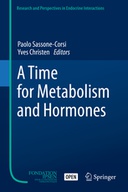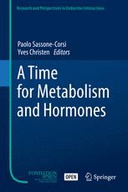Explore

A Time for Metabolism and Hormones
Each morning we wake up from a night of sleep, and each day we eat our regularly timed meals, go through our normal routines, and fall asleep again for another night. This rhythm, so-called circadian—after the Latin words circa diem (“about a day”)—underlies a wide variety of human physiological functions, including sleep–wake cycles, body temperature, hormone secretion, exercise activity, and feeding behavior. Circadian rhythms are remarkably conserved throughout evolution, and it is becoming commonly appreciated that circadian rhythms represent an exquisite example of systems biology.
At the heart of all cyclic biological functions is the circadian clock, a highly conserved molecular system that enables organisms to adapt to common daily changes, such as the day–night cycle and food availability. The mammalian anatomical structure in the brain that governs circadian rhythms consists of a small area of the anterior hypothalamus, called the suprachiasmatic nucleus (SCN). For decades, this “central pacemaker” was thought to be the unique circadian clock of the organism. This dogma was challenged when peripheral tissues were also found to contain functional circadian oscillators that are self-sustained at the single cell level. This notion, together with the discovery that a remarkable fraction of the genome is transcriptionally controlled by the clock, illustrated that circadian control must play a key role in governing the metabolism and physiology of all organisms. This concept was recently validated by studies of the metabolome revealing that a large fraction of metabolites oscillate in a given tissue. Recent years have seen spectacular advances in the field of circadian biology. These have attracted the interest of researchers in many fields, including endocrinology, neurosciences, cancer, and behavior. By integrating a circadian view within the fields of endocrinology and metabolism, researchers will be able to reveal many, yet-unsuspected aspects of how organisms cope with changes in the environment and subsequent control of homeostasis.
The concept behind the Fondation IPSEN Colloque Medecine et Recherche on “A Time for Metabolism and Hormones,” held in Paris on December 5, 2014, was to capture the excitement of this field as it is opening new avenues in our v understanding of metabolism and endocrinology. A panel of the most distinguished investigators in the field gathered together to discuss the present state and the future of the field. These proceedings constitute a compendium of the most updated views by these investigators
This book is included in DOAB.
Why read this book? Have your say.
You must be logged in to comment.
Rights Information
Are you the author or publisher of this work? If so, you can claim it as yours by registering as an Unglue.it rights holder.Downloads
- 6 - pdf (None) at Google Books.
- 126 - pdf (CC BY-NC) at OAPEN Library.
- 232 - mobi (CC BY-NC) at Unglue.it.
- 251 - pdf (CC BY-NC) at Unglue.it.
- 355 - epub (CC BY-NC) at Unglue.it.
Keywords
- Autism Spectrum Disorders
- cell biology
- circadian clock
- circadian post-transcriptional control
- circadian rhythms
- endocrinology
- Human physiology
- Medical profession
- medicine
- Medicine: General Issues
- Neurosciences
- sleep-wake cycles
- suprachiasmatic nucleus
- thema EDItEUR::M Medicine and Nursing::MB Medicine: general issues::MBD Medical profession
Links
DOI: 10.1007/978-3-319-27069-2web: https://link.springer.com/book/10.1007/978-3-319-27069-2
Editions


